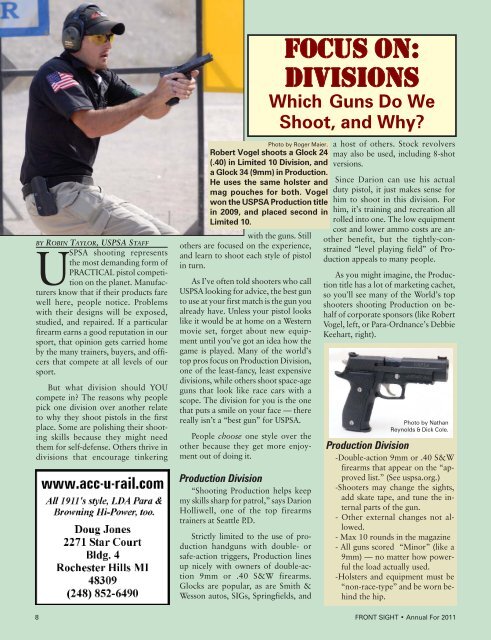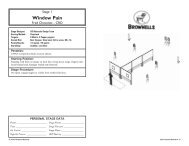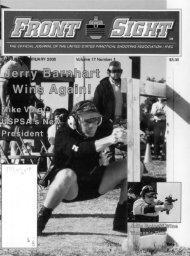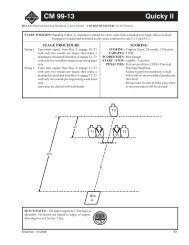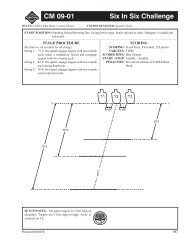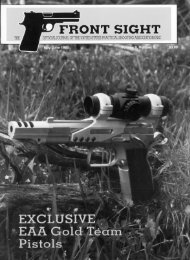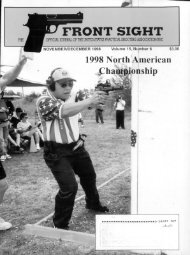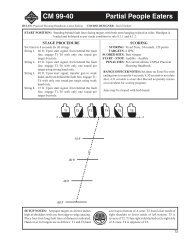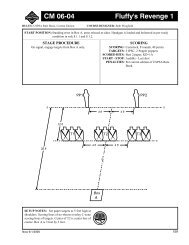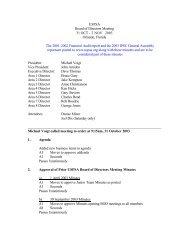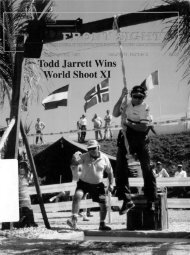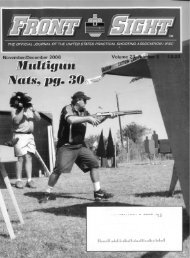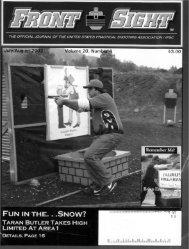Create successful ePaper yourself
Turn your PDF publications into a flip-book with our unique Google optimized e-Paper software.
BY ROBIN TAYLOR, USPSA STAFF<br />
USPSA shooting represents<br />
the most demanding form of<br />
PRACTICAL pistol competition<br />
on the planet. Manufacturers<br />
know that if their products fare<br />
well here, people notice. Problems<br />
with their designs will be exposed,<br />
studied, and repaired. If a particular<br />
firearm earns a good reputation in our<br />
sport, that opinion gets carried home<br />
by the many trainers, buyers, and officers<br />
that compete at all levels of our<br />
sport.<br />
But what division should YOU<br />
compete in? The reasons why people<br />
pick one division over another relate<br />
to why they shoot pistols in the first<br />
place. Some are polishing their shooting<br />
skills because they might need<br />
them for self-defense. Others thrive in<br />
divisions that encourage tinkering<br />
8<br />
with the guns. Still<br />
others are focused on the experience,<br />
and learn to shoot each style of pistol<br />
in turn.<br />
As I’ve often told shooters who call<br />
USPSA looking for advice, the best gun<br />
to use at your first match is the gun you<br />
already have. Unless your pistol looks<br />
like it would be at home on a Western<br />
movie set, forget about new equipment<br />
until you’ve got an idea how the<br />
game is played. Many of the world’s<br />
top pros focus on Production Division,<br />
one of the least-fancy, least expensive<br />
divisions, while others shoot space-age<br />
guns that look like race cars with a<br />
scope. The division for you is the one<br />
that puts a smile on your face — there<br />
really isn’t a “best gun” for USPSA.<br />
People choose one style over the<br />
other because they get more enjoyment<br />
out of doing it.<br />
Production Division<br />
“Shooting Production helps keep<br />
my skills sharp for patrol,” says Darion<br />
Holliwell, one of the top firearms<br />
trainers at Seattle P.D.<br />
Strictly limited to the use of production<br />
handguns with double- or<br />
safe-action triggers, Production lines<br />
up nicely with owners of double-action<br />
9mm or .40 S&W firearms.<br />
Glocks are popular, as are Smith &<br />
Wesson autos, SIGs, Springfields, and<br />
FOCUS On:<br />
DIVISIONS<br />
Which Guns Do We<br />
Shoot, and Why?<br />
Photo by Roger Maier.<br />
Robert Vogel shoots a Glock 24<br />
(.40) in Limited 10 Division, and<br />
a Glock 34 (9mm) in Production.<br />
He uses the same holster and<br />
mag pouches for both. Vogel<br />
won the USPSA Production title<br />
in 2009, and placed second in<br />
Limited 10.<br />
a host of others. Stock revolvers<br />
may also be used, including 8-shot<br />
versions.<br />
Since Darion can use his actual<br />
duty pistol, it just makes sense for<br />
him to shoot in this division. For<br />
him, it’s training and recreation all<br />
rolled into one. The low equipment<br />
cost and lower ammo costs are another<br />
benefit, but the tightly-constrained<br />
“level playing field” of Production<br />
appeals to many people.<br />
As you might imagine, the Production<br />
title has a lot of marketing cachet,<br />
so you’ll see many of the World’s top<br />
shooters shooting Production on behalf<br />
of corporate sponsors (like Robert<br />
Vogel, left, or Para-Ordnance’s Debbie<br />
Keehart, right).<br />
Photo by Nathan<br />
Reynolds & Dick Cole.<br />
Production Division<br />
-Double-action 9mm or .40 S&W<br />
firearms that appear on the “approved<br />
list.” (See <strong>uspsa</strong>.org.)<br />
-Shooters may change the sights,<br />
add skate tape, and tune the internal<br />
parts of the gun.<br />
- Other external changes not allowed.<br />
- Max 10 rounds in the magazine<br />
- All guns scored “Minor” (like a<br />
9mm) — no matter how powerful<br />
the load actually used.<br />
-Holsters and equipment must be<br />
“non-race-type” and be worn behind<br />
the hip.<br />
FRONT SIGHT • Annual For 2011


